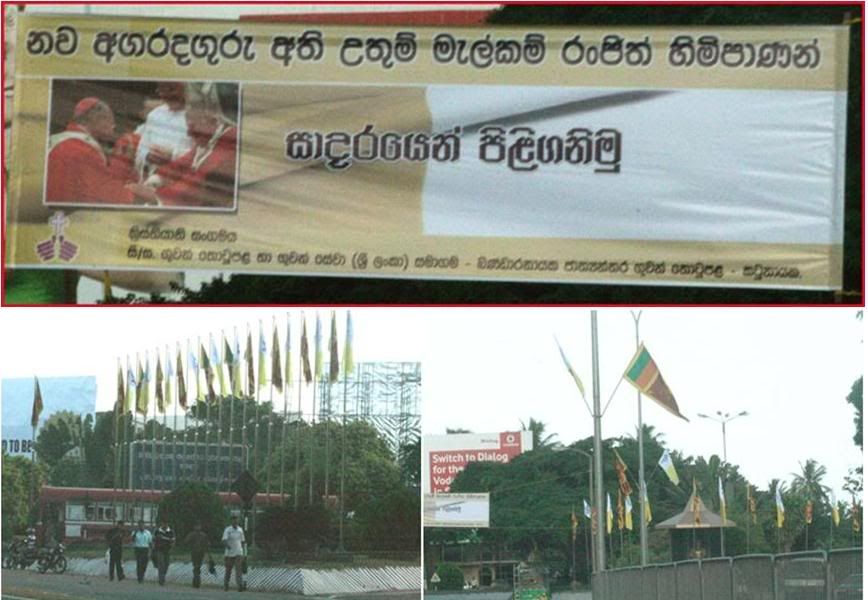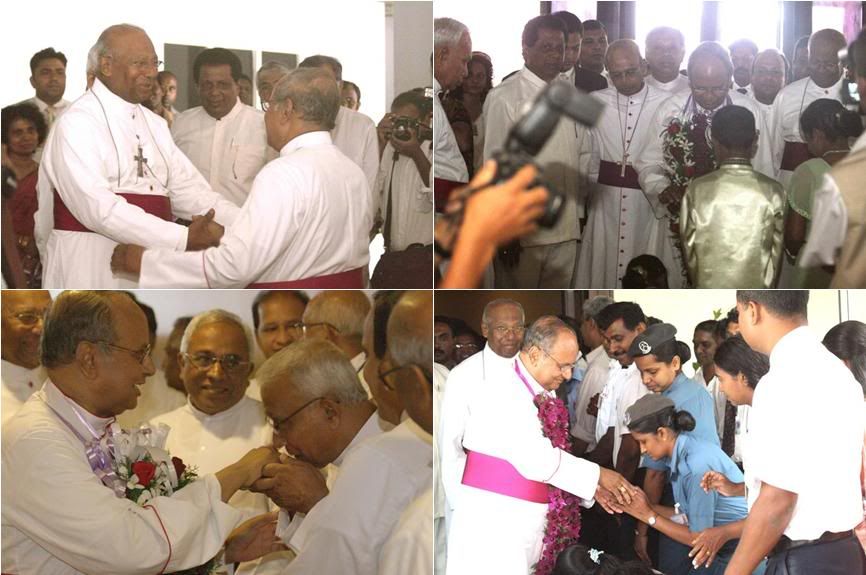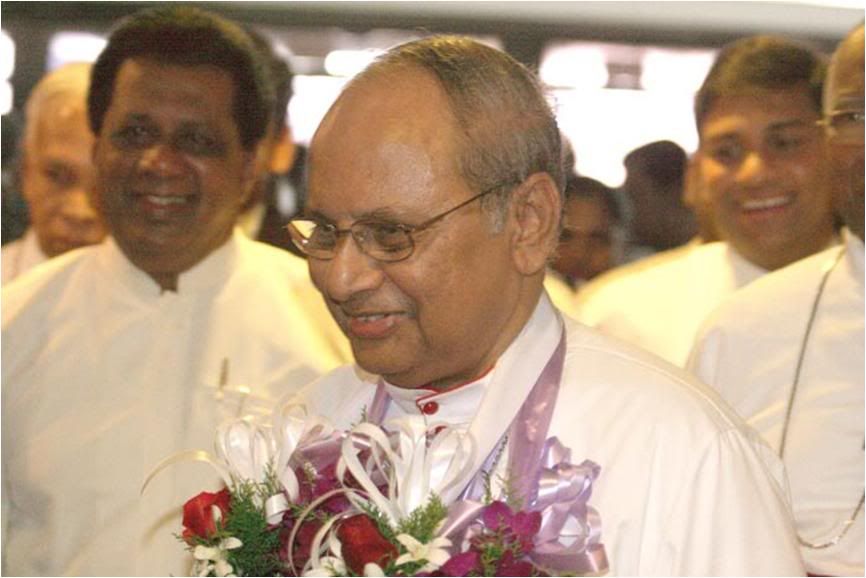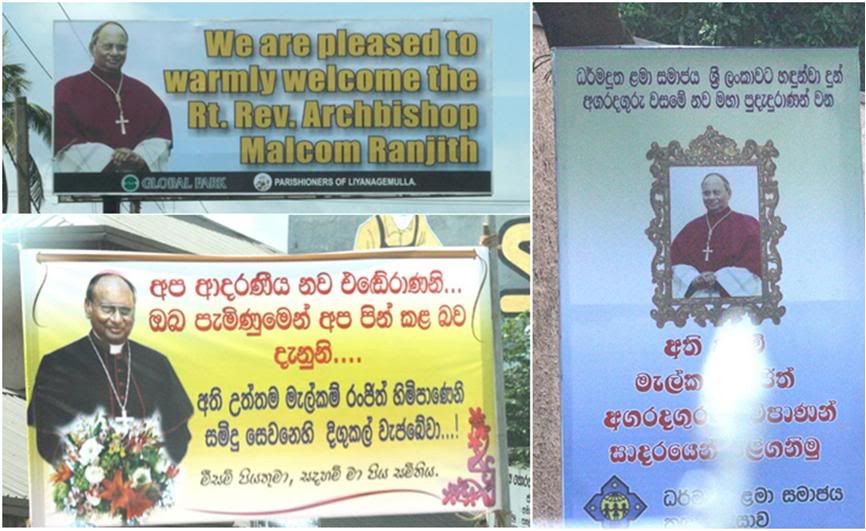 In the preceding page is an article on Mons. Ranjith's installation as Archbishop of Colombo and an interview he gave to Avvenire before he left Rome.
COMING HOME TO COLOMBO
In the preceding page is an article on Mons. Ranjith's installation as Archbishop of Colombo and an interview he gave to Avvenire before he left Rome.
COMING HOME TO COLOMBO
On the website of the Archdiocese of Colombo, I found a number of pictures taken upon the arrival of Mons. Ranjith in Colombo on 7/31/09, and I thought I would post some of them here, because it was apparently a big local event - doubly significant and remarkable because Sri Lanka is predominantly Buddhist.
And yet, Archbishop Ranjith got the works - an airport news conference, Vatican flags alternating with the national flag along the way, streamers to welcome him, flag-waving crowds. (Not even in my country, the Philippines - at least 80% Catholic and Asia's most Catholic country - did we put on such a show to welcome home any of our three bishops who became cardinals after they got back from their respective consistories.]
It's a testimony to what he said in the earlier interview about the important role that the Catholic Church is perceived to have in Sri Lanka.
The first person to welcome Mons. Ranjith home is his predecessor, Mons. Oswald Gomis.






 Another item of interest from the diocesan site is a 2006 interview with Mons. Ranith by 30 GIORNI a few months after he was called to Rome by Pope Benedict XVI to serve at the CDW. It's a lengthy one, but I will post the part where he talks about his relations with Cardinal Ratzinger then Pope Benedict, and about the liturgy; and later, where he talks about what he did during the Dec. 2005 tsunami (he was the Nuncio in Jakarta, and he happened to have Cardinal Schoenborn as his house guest at the time, and they both ended up helping mobilize international Catholic adi from Bandar Aceh.)
Interview with Mons. Ranjith
Another item of interest from the diocesan site is a 2006 interview with Mons. Ranith by 30 GIORNI a few months after he was called to Rome by Pope Benedict XVI to serve at the CDW. It's a lengthy one, but I will post the part where he talks about his relations with Cardinal Ratzinger then Pope Benedict, and about the liturgy; and later, where he talks about what he did during the Dec. 2005 tsunami (he was the Nuncio in Jakarta, and he happened to have Cardinal Schoenborn as his house guest at the time, and they both ended up helping mobilize international Catholic adi from Bandar Aceh.)
Interview with Mons. Ranjith
by GINNI CARDINALE
Translated from

'''
How did you meet Cardinal Joseph Ratzinger?
In connection with a question concerning Sri Lanka, that of the theologian Fr.Tissa Balasuriya, who had written a book,
Mary and Human Liberation, which contained a theological analysis hardly compatible with Catholic doctrine.
I was a young bishop then, just appointed. I took an interest in the book and an episcopal commission specially created to scrutinize the text was set up by the Bishops. In 1994, at the conclusion of the Commission’s work, the Bishops’ Conference released a communiqué in which the faithful were told that the book did not mirror the doctrine of the Church. This communiqué provoked a worldwide press campaign against us and in favor of Father Balasuriya.
The controversy was so loud that Rome also began to investigate. And so I was summoned to the Vatican to explain what was happening to the Pope and to the Prefect of the Congregation for the Doctrine of the Faith, Cardinal Ratzinger.
Father Balasuriya’s errors were so serious that in January 1997 they were formally condemned by the Congregation, and he himself, since he wouldn’t withdraw them, suffered excommunication latae sententiae. An excommunication that was withdrawn the following year, after a solemn public declaration by Father Balasuriya.
So it was in that context that your acquaintance with Cardinal Ratzinger began
Yes, and subsequently, I met him several times. On those occasions I had the chance to tell him of my impressions and my concerns as bishop especially with regard to the question of inter-religious dialogue and also liturgical questions.
When I was later called to Propaganda Fide [the Congregation for the Evangelization of Peoples, to which John Paul II named him secretary], I had the opportunity of meeting Cardinal Ratzinger more frequently, even for the everyday business of the dicastery, to which he also belonged.
So, apart from being an avid reader of his books, I learned in person to esteem his human gifts. I’ve always seen a great theologian in him and in his words, not a pedant at all, but a person close to the Lord.
So you were in Jakarta [as Apostolic Nuncio - his assignment after Propaganda Fide] a little less than two years. On 10 December 2005, your nomination as Secretary of Divine Worship was made known. Were you expecting the new call to Rome?
I remember that Benedict XVI summoned me to an audience in Castel Gandolfo during the summer of 2005, it was mid September, and he asked me whether I would accept to be the secretary of the Congregation for Divine Worship. It was his request and so I said yes.
I’ve always had an interest in the liturgy, which I’ve considered the key to understanding the relationship between faith and life, because I believe that as the liturgy is celebrated, so the Christian faith is lived.
On the one hand, the liturgy externalizes faith; on the other, it feeds it. To be able to offer my modest contribution on this point, which is something close to the heart of Pope Benedict, has filled my heart with joy.
Your Excellency, your first public utterance as Secretary of the Congregation for the Divine Worship was a speech in April 2006 at the launching of the book by Uwe Michael Lang, an Oratorian of German origin who lives in London [Last year, the Holy Fahter asked Fr, Lang to come to Rome to work in teh CDW]. The book is Rivolti al Signore. L’orientamento nella preghiera liturgica [Turned to the Lord. Orientation in liturgical prayer] (Cantagalli, Siena 2006, pp. 150, Euro 14.90). First published in German in 2003, it has a preface by the then Cardinal Joseph Ratzinger. What struck you most about the book?
I had already read the book and the very fine preface by the then Cardinal Ratzinger. Then when I received the invitation, I immediately accepted. Because it was the occasion to create a very positive debate within the Church.
There’s a lot of talk about the participation of the faithful in the liturgy.
But do the faithful participate more if the priest celebrates versus populum or if he celebrates toward the altar? It’s not at all certain that participation is more active if the priest celebrates toward the people; it may be that people become more distracted.
Is it real participation when, at the sign of peace, a great confusion is created in the church, with some priests at times going down to give their greetings even to those in the rear pews?
Is it
actuosa participatio, as intended by the Second Vatican Council, or simply a big distraction that doesn’t help at all in creating the sense of meditation and devotion necessary for the moment of communion. Besides, at times even the recitation of the Agnus Dei is forgotten…
I repeat, Father Lang’s book has been and is a most useful provocation, starting from the introduction in which Cardinal Ratzinger reminds us that the Council never asked for the abolition of Latin nor the revolutionizing of the direction of liturgical prayer…
An interview of yours in La Croix of 25 June 2006, entitled 'The liturgical reform of Vatican II has never taken off', attracted a lot of attention. Can you clarify your views on the liturgical reform put into effect after Vatican Council II?
Those words have been taken out of context. It isn’t that I judge negatively everything has happened after the Council. I said instead that the results expected from liturgical reform are still not manifest.
One wonders whether liturgical life, the participation of the faithful in sacred functions, is greater and better today compared to that of the 1950s.
There has been criticism of the fact that before the Council the faithful didn’t really participate in the Mass, but were passively present or engaged in personal devotions. But do the faithful today really participate in a more spiritually elevated and personal way?
Did the many who had left the Church start queuing up to get into our churches when the new liturgy was introduced? Or hasn’t it happened instead that many more have stopped going to Mass and that the churches have emptied? What reform are we talking about therefore?
The result of secularization?
Certainly, but the situation is also the outcome of the way in which the liturgy has been treated or, rather, mistreated … In practice, I think the sacrosanct expectations of the Council for a better understood and therefore more spiritually fecund liturgy have still not been realized. And so there is still much to do, so that the churches may fill up again with new faithful who really feel touched by the grace of the Lord during the sacred liturgies.
In a secularized world, instead of seeking to raise hearts toward the greatness of the Lord, the effort has been to reduce the divine mysteries to a trivial level.
When you were nominated secretary of Divine Worship, it was expected that you would have excellent relations with the Lefebvrian world. Is that so ?
I never met Monsignor Marcel Lefebvre because of the age difference - he belonged to another era. I certainly have had contact with some of his followers. But I’m not a fan of the Lefebvrians. Unfortunately they still haven’t re-entered into full communion with the Holy See, but what they sometimes say about the liturgy, they say for good reason. And therefore they’re a goad that should make us reflect on what we’re doing.
That doesn’t mean that I can be described as an adherent or a friend of the Lefebvrians. I share some points with the so-called No-globals on social justice, but that doesn’t mean I’m one of their adherents
On the other hand the Tridentine mass is not the private property of the Lefebvrians. It is a treasure of the Church and of us all. As the Pope told the Roman Curia last year, Vatican Council II was not a break, but a renewal in continuity. One does not throw away the past, but one grows on it.
...
About the tsunami:
It was precisely during your stay in Jakarta that Southeast Asia was hit by the terrible tsunami. What was that experience like?
The archbishop of Vienna, Cardinal Christoph Schönborn, a dear friend of mine, was staying with me at the time. When we heard of the tragedy, we abandoned the program already arranged for him and we went to Banda Aceh.
It was an extremely difficult journey, but we managed to arrive and visit the stricken areas. It was a terrible spectacle: death and destruction everywhere. We spent two days with missionaries, we slept where we could, without running water and without electricity.
But we were content to be near the small Catholic community of Banda Aceh and also of the island of Nias. The voice of Cardinal Schönborn speaking on the European media from the area and telling of his experience was also decisive for the solidarity shown from all over the world.
Later through the Caritas network and the help of the Holy See we managed to set up a solid aid program for the people. The Indonesian Caritas was inactive, and so with the help of the Cardinal Archbishop of Jakarta and of Caritas Internationalis we managed to reactivate that ecclesial body and to set up aid projects for the rebuilding of those areas.
I remember that we took part in endless but important meetings with civilian authorities, thanks to which we were able to make our contribution as Catholic Church to the people stricken by this monstrous tragedy.
Mons. Ranjith gave this interview in 2006. I wonder if he saw the Mahony-like circus Mass that his good friend Cardinal Schoenborn celebrated in Vienna two years later - and what would he have said to him?
[Modificato da TERESA BENEDETTA 10/08/2009 02:58]